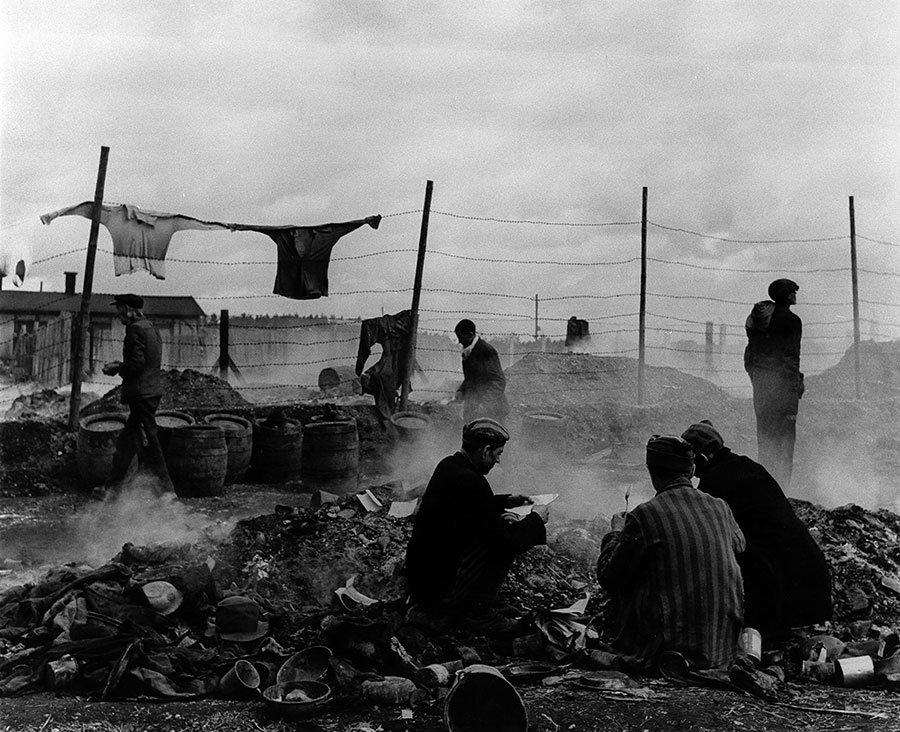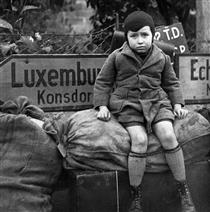Photojournalist Profile
Lee Miller
Photo By Jenna Ross
In the photo on the right below, Lee Miller captures a fallen SS solider floating in a canal. Miller uses quality of light to show the shimmering light of the water. It's a picture with a dark back story, so the bright light bouncing off the water is ironic. Some of the water is incredibly dark, almost black, but also on the other end of the spectrum of bright light. Texture is also used here. The water is washing over the man's face, and the reflection is almost pretty looking. His jacket is also soaking wet. Even though he is floating peacefully, the viewer knows he is absorbing all the water and is very heavy. This photo is also incredibly in focus. All aspects of the image are sharp including the blades of grass, wrinkles in the jacket, or ripples in the water. I think this is to show the detail of the photo and makes it feel like a heavenly scene. However, the man is actually dead.
Photo By Man Ray Photo By Lee Miller
The photo on the left below is of two women sitting in front of a destroyed building in Cologne, Germany. The subjects' expression in this photo is quite emotionless. Their body language is straightforward and they seem unbothered by their surroundings. It seems they are either in complete disbelief and denial, or are all too used to the desecration of their home. The background distracts from the composition. The background of the destroyed building drags your attention away from the women on the bench. The women on the bench makes the photo human and something the viewer can understand. However, without the background of the building, the photo would not be anything special. Lastly, this photo is very cluttered. The rubble of the building is dispersed throughout the background. There are also a lot of different highest and depths of the building. Areas further still have the height, but the front of the building is shorter from being destroyed.
Photo By Vogue Photo By Lee Miller
The photo on the right below is of the recently liberated prisoners of a concentration camp in Dachau, Germany shift through rubble. The contrast of this photo is very high. The dark areas are incredibly dark while the brighter parts are just that. This creates a certain look of the people in the photo. They are just dark, silhouetted figures. There is little individuality between them and it shows the loss of life they went through during interment. This image creates a feeling of shock. Even for a viewer who has seen multiple pictures like this, the reality is shocking. I can only imagine how striking this image would be for people far removed from the war during this time. It was the first time something like this had been documented and it was incredibly horrific. Lastly, depth of field is used by Miller. The viewer can see three prisoners up front. There is also a building further back. Even further back, through the smoke, you can see mound of rubble and fencing.
Photo By David E. Scherman Photo By Lee Miller
The photo on the bottom right is a photo by Lee Miller of a young, starving child in Luxemburg, Germany. The main subject is obvious in this photo. It is a personal shot of a young, distressed child. They have a look of longing and desperation. This photo shows the type of distress the war put on young children. The use of lines is also evident. There are multiple types of lines here. Some in the background are straight from the signs. There is also a sagging line where the child is sitting. The sunken outline of the sack matches the sunken disposition of the child. There is also the rule of thirds. The child is on the outskirts of the photo. Similarly, children are sensitive subjects during time of war and struggle. This desperate child being pushed to the periphery of life, as he is being pushed to the side of the photo.
1. Career path
Lee Miller was a American photographer with a history in many different fields. Encyclopedia Britannica published the article Lee Miller that explained her career in photography throughout her life. Miller first focused on surrealism, modeled for other surrealist photographers, and even molded. Miller molded for Vogue magazine both in Europe and the United States. She even began a process in her own fashion photography. She continued on this path until 1943 when she became a war correspondent for Vogue and partnered with a Life photojournalist and followed the 83rd Infantry Division of the U.S Army during World War II. https://www.britannica.com/biography/Lee-Miller
2. Era
Miller was born in 1907 when photojournalism in magazines was incredibly popular. Miller was affiliated with Vogue magazine in it's early years when fashion and life was portrayed in the utmost classy and glamorous ways. After partnering with Life magazine photographer, Miller worked with two of the most popular displays of photojournalism. According to Art in America in the article Photographer Lee Miller's Subersive Career Took her from Vogue to War-Torn Germany , "Miller’s images would help to transform the luxury-oriented fashion magazine, which at the time had found itself ill-equipped to meet the war-torn moment, into an outlet for serious news." As a World War II photographer, Miller captured some of the first photographic images on the scenes of the Holocausts. She was at the Liberation of Paris, covered the filed hospitals at Normandy, and captured evidence of the Buchenwald concentration camp. Lee Miller was amongst the first photojournalists to capture an era of unrest and captured the true crimes of humanity in a male dominated profession.
3. Motivation
Lee Miller developed many different relationships that motivated and inspired her career path. Miller has a long journey of traveling the world. While she had a successful life beforehand, Miller developed an successful relationship with surrealist partner, teacher, and lover, Man Ray. She describes her draw to Man as her start to her career by saying "I thought the best way was to start out studying with one of the great masters in the field, Man Ray." He was her inspiration that drover her solo work when she went back to New York. Art in America in the article Photographer Lee Miller's Subversive Career Took her from Vogue to War-Torn Germany , quotes Miller by her motivation was her "restlessness" to experience as many different career paths as possible.
4. Technology
Because Lee Miller had such a vats history and complex career path, her use of technology was incredibly varied. Her most notable photographic advancement was during her days as partner and muse of Ray Man. The article Lee Miller- Biography and Legacy by The Art Story explains how Miller created the idea of solarization that Man used in much of his work. By turning the lights on in Man's darkroom, Miller created a high contrast, ghostly image. During the time that Miller was both modeling and shooting for Vogue, she learned a lot about phogrpahy. However, it was her work with Man Ray that led her to her photojournalistic style. In an article by Kelly Richard-Abdou called Lee Miller: Fashion Model, Surrealist, and Fearless War Correspondent, Lee Miller is depicted as a women wanting change and since nobody "was going to give her a gun or an airplane, or something useful like that—so she used her camera." During this time, she shot with a smaller camera and worked with angles to get the correct composition as explained by the article Lee Miller- Biography and Legacy.
5. Ethics
As a photojournalist, Lee Miller was a pioneer in many areas. Being a femal war correspondent as well as being the first to capture specific styles of pictures. The article Lee Miller- Biography and Legacy. by the Art Story explains some of the controversial images by. Many of her photos at this time used a "confrontational style of her then-innovative, close-up images from 1945 of starving children in Vienna have also become commonplace in photography, the intimate perspective a shorthand for creating a connection between a viewer and the subject." Many of her photos depicted close-up, never before seen images of grueling events, such as genocide at a time when people were "playing at life rather than having to take it seriously, at a time when war seemed imminent."
6. Bias
The time of Lee Miller's war correspondent days led her to capturing truth. Miller established her name on being the beautiful inspiration for glamourous, fashion-forward work. But she wanted to show that truth. The article Photographer Lee Miller's Subversive Career Took her from Vogue to War-Torn Germany quotes Miller when she says “I usually don’t take pictures of horrors. But don’t think that every town and every area isn’t rich with them.” It was her goal for these disturbing truths to be known and in a telegraph to the editor of Vogue she writes, “I IMPLORE YOU TO BELIEVE THIS IS TRUE!...I hope Vogue will feel that it can publish these pictures.” Lee Miller did not want to hide these incredibly disturbing horrors, but rather make it known what kind of evils existed. Miller refused to let her past occupations define her future.
8. Impact
Lee Miller made an enormous impact in the world of photojournalism. To begin with, Miller inspired everybody around her with her beauty. Iconic artists such as Man Ray and Picasso used Miller as their muse while immortalizing her grace. In the world of photojournalism, Lee Miller changed the face of media outlets like Vogue from portraying pictures of surface level class to publishing hard-hitting real life events. For the face of feminism, Miller was a key figure in a male dominated profession, war photography, and created some of the most influential works.
9. Viewpoints
Lee Miller has a distinct history unique to her. To some, she was the face of sexual assault and exploitation by her father and some companies. Others saw her as a beautiful model working in high end fashion while also contributing to her own career as a photographer. During World War II, Miller was an eye for people back home to see the horrifying reality of instances like the Holocausts. Despite all her amazing feats, some of Lee Miller's most influential work was not discovered until her son discovered her archive of work hid away, according to Encyclopedia Britannica in the article Lee Miller.
10. Major at AIC
As an occupational therapy major, I related most to Lee Miller's incredible drive. She defied odds as being a strong female voice in the photography of World War II. However, she managed to remain humble. I aspire to be as influential in my filed, but keep my humility. Like Lee Miller, I want to break boundaries and make unexpected bounds. With this, I want to inspire those around me.













Comments
Post a Comment